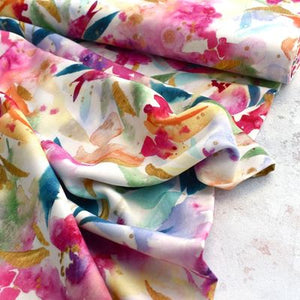The summer is quickly approaching, and who among us is looking forward to another opportunity to try on a bunch of ill-fitting, too-revealing/overly-modest swimsuit styles in a public dressing room (and don’t forget those fun “sanitary” stickers!)? NO ONE? Guess what! You can skip all of that awkwardness and confidently spend your time in the sun wearing a swimsuit made by you! From choosing your favorite print or color fabric, to selecting the style that perfectly accentuates what you want while subtly concealing what you don’t, all with a custom fit for your body, create the swimsuit of your dreams this season.
Though me-made swimwear can seem like an overwhelmingly tricky task, with the right fabric, tools, and a few helpful tips, you will be well on your way to making this the best swimsuit season yet!

Well-Suited Fabric
- Main Fabric—Making your own swimwear can be an undertaking and you want to ensure that your labor of love is worth the effort by purchasing quality fabric. This will allow you to enjoy your make for years to come! The best swimwear fabric has generous four-way stretch, excellent recovery, and includes a good amount of spandex (typically 10+%). Most popular swimwear knits are a blend of nylon and spandex, but a polyester/spandex blend will also work well. Other things to check include it it is resistant to UV rays from the sun, chlorine, and saltwater, all of which can degrade fabric rather quickly.
- Lining Fabric—Though every swimsuit pattern does not call for a lining, you may choose to add one anyway based on the level of transparency of the main fabric along with your own comfort level. Aside from adding additional coverage, lining your swimsuit can give additional support to your garment, and give you the option to easily incorporate other supportive elements such as a shelf bra or bra cups. Should you decide to line your swimsuit, here are a few options to consider.
- Swimsuit Lining—As you might guess this light weight knit substrate is made specifically for lining swimsuits. It is mainly produced in basic, solid colors (white, black, beige) and typically has similar stretch percentages as your main swimwear fabric.
- Power Mesh—Similar to its use in lingerie, this is primarily used for extra support or contouring in specific areas, such as the bust, belly and/or bottom. The stretch percentage of this fabric is often lower than that of swimsuit fabrics, so sizing up or other adjustments may be needed.
- Self-Lined—Many patterns call for lining suits with the same, or similar, fabric you used on the outside. This also works great for reversible swimwear. Though you do not need to worry as much about the stretchability, the two layers of swimwear fabric will be a bit bulkier than using a single layer plus lining, and sizing up may be necessary for a more comfortable fit.
Sew Smart! When adding foam swim cups for additional support or modesty, a good tip is to add them as close to finishing your suit as possible, in order to make sure that they are placed correctly. You want to have as much construction of the suit completed as you can before completing this step.

The (Not Too) Bare Necessities
- Thread—Standard polyester thread is best for constructing swimwear and ensuring that your suit will hold up to the repeated stretching. Wooly nylon thread is another good alternative option if you are looking for a bit more give in your suit, though it should only be used as the bobbin thread if you are constructing your suit with a sewing machine.
- Needles—Skipped stitches are a friend to no sewist, and unfortunately, they are more likely the higher the stretch percentage your fabric happens to be. The best way to avoid those dreaded gaps in your seam line is by choosing the correct size and type of needle for your project. Stretch needles in size 75/11 or 90/14 are going to be the best option for sewing swimwear fabric with the high spandex content. As an alternative, ballpoint or jersey needles in a similar size may also work.
- When sewing elastic into swimwear, some prefer to switch to a Microtex needle whose extra-sharp point can go through the multiple layers quite easily.
- Consider using a stretch twin-needle for topstitching your project. It can add a professional-looking finish to your me-made swimsuit!
- Pins—Not surprisingly, it is also recommended that ballpoint pins be used while working with swimwear substrates to avoid large holes or snags in your fabric during construction. Or avoid pins completely with Wonder Clips, which can be quite helpful keeping various layers and elastic in place!
- Elastic—Whenever possible make sure to use either rubber or cotton swim elastic that has been specifically labeled as “chlorine-resistant”. Just like your main swimwear fabric, these elastics have been produced to withstand the wear and tear and exposure to the elements, like saltwater and chlorine, that swimwear will likely encounter. Using the same standard polyester elastic found in other garments and lingerie may significantly decrease the life of your suit.
Sew Smart! If you are new to sewing swimwear, or you’re not completely sure about the fit of a new pattern, try using dissolvable thread. Used only in the bobbin, this genius notion gives sewists the ability to make a muslin out of the same fabric they intend to use for their final make!
Just sew the main components of your suit per the pattern instructions, try it on to test the fit, then a quick dip in water (just for the suit - not the maker!), and you can watch the entire thing come apart without having to reach for your dreaded seam ripper. This way, you can plan any necessary changes in the seam allowances or length of the straps without damaging your precious fabric.

Construction Instruction
- Serger vs. Sewing Machine—The general impression in the sewing community seems to be that a serger is necessary for swimsuit construction, and that is definitely not the case! You can have the same spectacular results utilizing a sewing machine or a serger – or even a combination of the two, should you choose. Whichever machine you end up working with, always test your tension settings and stitch length on a scrap piece of fabric before you start.
- Stitch Types—It should come as no surprise that a garment as stretchy as a swimsuit needs to be sewn with stretch stitches. What may be surprising is that there are a variety of options that will fit the bill. The trusty zig-zag stitch will always work and can be found on almost every sewing machine. If you have a machine with a few additional choices, the triple zig-zag or stretch stitch (aka the lightning bolt stitch) also works well. You can use the zig-zag stitch on a wider setting or switch over to your stretch twin needle for topstitching to finish your garment with style!

Swimwear Care Do’s and Don’ts
- DO NOT Iron—Swimwear likes to be worn in hot weather, but may melt under the more intense heat of your iron. Finger-pressing and topstitching seams down for a clean finish are much safer options.
- DO Rinse ASAP—Always rinse your suit with clean water as soon as possible (preferably before it is able to dry on its own). Although your swimwear fabric is somewhat protected from chlorine, saltwater, and UV rays, this extra attention will help make sure suit lasts for many vacations and seasons to come!
- DO NOT Use the Dryer—Maintaining the elasticity of your swimwear is the key to keeping that fabulous fit for the life of your suit. Similar to other fabrics made with spandex or lycra, the heat from the dryer can weaken the fibers overtime, degrading the recovery of your fabric, and allowing your suit to stretch out.
- DO Wear With Pride!—Strut like a peacock! Show off that gorgeous me-made and fabulous body wearing it! Loudly announce to any and all passersby, “Why, yes, I DID make this swimsuit myself!” Take pride in two beautifully unique creations – your suit and the person who made it!








I was hoping that your article would have addressed the all-important “torso length”. Since swimwear fabric stretches vertically as well, how is one to know how much to lengthen or shorten the pattern for fit?
Thank you soooo much for your swimwear tips. I have a serger,however I have not made a garment yet. Sick and tired of trying to find a suit that fits me. So, I will eventually take the plunge. Thank you again. Donna
Leave a comment